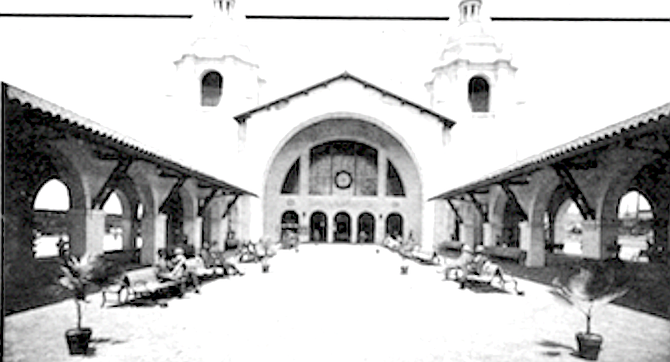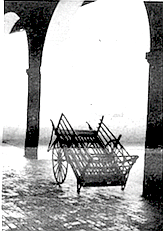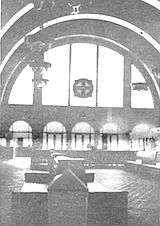 Facebook
Facebook
 X
X
 Instagram
Instagram
 TikTok
TikTok
 Youtube
Youtube



These days, one can wander into the Santa Fe depot, downtown San Diego, and feel like a ghost. The imagination of a train buff can easily supply the atmosphere of a busy center of rail transportation, the hub of a city’s activity, the place where so many dreams once began and ended. But one who enters the depot without imagination in high gear is faced with the cool, lofty emptiness of an aging masterpiece of architecture (dated 1915), outmoded and underused through the fault of nothing but the changing times.
Five years ago, with the depot looking more and more like a white elephant, talk began about what to do with it. The Santa Fe Railroad unveiled plans for twin office towers on the site. The depot would be demolished to make way for the new $46 million project.
That was when San Diego began to realize it didn’t want to lose another landmark. Who doesn’t feel a twinge of regret that the Coronado ferry is a rapidly-fading memory? So, the Save Our Heritage Organization (SOHO) began working to prevent the demise of the depot.
“When we first took up the project, we thought the odds were insurmountable,” said Bill Cartwright, president of SOHO. “Nobody thought we could beat the Santa Fe Railroad. But we showed ’em.”
The goal of SOHO’s rise to the challenge is close to becoming reality. Construction will begin this summer to convert the depot into a “specialty center” serving San Diego residents, commuters, and visitors with everything from a city transit terminal to restaurants and shops of all kinds. Best of all, the trains will still be stopping there.
Cartwright recounted SOHO’s role in saving the depot.
“Our plans were simply to save the damn thing for any use,” he said. “We don’t take total credit for saying it, but we do take credit for providing the impetus. We just made a big stink about it, and the government people took it from there.
If it hadn’t been for Pete Wilson we would’ve been nowhere.”
The restored depot will consist of 99,000 square feet of space “under roof,” according to Skip Burrows of Grubb and Ellis Commercial Brokerage company, which handles leasing arrangements. This includes 77,000 square feet of net leasable space (“income producing square feet”), with the remainder consisting of mall area and rent-free space provided for San Diego Transit and the Dial-a-Ride headquarters.
‘This is not going to be just a tourist attraction,” Burrows proclaimed. “We’re not devoting it to any one group.” He cited the 57,000 workers downtown as a prime group of potential users of the facility, which will include three major dinner houses, two specialty restaurants, and one or two financial institutions. The rest will be devoted to dozens of specialty shops, including gift shops, macrame, Mexican imports, candle makers, clothing shops, a kite shop, and even a guitar maker. The largest shop will occupy only 1300 square feet.
Rents are still being negotiated, but indications are they will be high. “Rent is a function of volume,” Burrows said. ‘These shops will be geared toward doing a lot of volume in a small space. If you can do the volume, rent is no big problem. This is a new thing to San Diego, and rents will be competitive with similar things in other areas.”
The most often cited similar thing is Ghirardelli Square in San Francisco. But those involved in the depot’s future are reluctant to draw too close a parallel.
“The key word is unique,” Burrows said.
Will prices at the new facility be as high as those at Ghirardelli-type centers?
“Of course we have no control over that,” he said. “I assume it will be whatever the traffic will bear.”
The depot project will be financed by a federal grant of $2.1 million from the Urban Mass Transit Administration and $6 million from the developer, Mape Industries. The city will purchase the depot from the Santa Fe Railroad with the federal funds and advance rents paid by the developer. Mape will then lease the structure for 55 years, according to Ed Riccio, project officer for the city Engineering and Development office. Tenants will sublease their space from Mape through the Grubb and Ellis firm. Riccio also emphasized that rental rates will be competitive, and will produce a reasonable profit for the developer. “Nobody works for nothing,” he added.
According to Riccio, the project is significant to a much greater area than just the comer of Kettner Boulevard and Broadway.
“The depot is located at the gateway to the city from the port,” he noted. “The project fits in with the total theme of the redevelopment of the waterfront, and it will be the nucleus for triggering a lot of development in the area.”
Of the $8 million cost of the restoration, the actual purchase price of the depot is $2,849,000.
The federal grant should be finally approved within six to eight weeks, Riccio said. The grant will trigger the final purchase of the property by the city, whereupon the city and Mape Industries will execute the long term lease, now in its final form.
Since the city will own the depot, it will no longer collect property taxes. However, it will collect possessory interest taxes from the lessee. Riccio pointed out that these taxes will provide more revenue, due to the improvement of the facility.
“It’s better for the city,” he said. “And another thing it will do is intensify retail activity and provide jobs for people.” Everyone from developers to history buffs seems satisfied with the progress being made, even though construction may not begin for another several months.
“We’re very happy about the whole project,” declared SOHO’s Cartwright. “Any alternative to demolition that preserves the architectural integrity of the building is acceptable to us. In order to preserve something for modem use, several adaptations have to be made.” ‘
Skip Burrows of Grubb and Ellis added that the depot’s outside will look the same. The inside will be true to the mission-style architecture, but give tenants the flexibility of design that will identify them.
Riccio verified the likelihood of a big celebration when the restored depot finally opens after a 12-month construction period, probably in the summer of 1977. “Oh, definitely,” he mused. “You oughta come down.”




These days, one can wander into the Santa Fe depot, downtown San Diego, and feel like a ghost. The imagination of a train buff can easily supply the atmosphere of a busy center of rail transportation, the hub of a city’s activity, the place where so many dreams once began and ended. But one who enters the depot without imagination in high gear is faced with the cool, lofty emptiness of an aging masterpiece of architecture (dated 1915), outmoded and underused through the fault of nothing but the changing times.
Five years ago, with the depot looking more and more like a white elephant, talk began about what to do with it. The Santa Fe Railroad unveiled plans for twin office towers on the site. The depot would be demolished to make way for the new $46 million project.
That was when San Diego began to realize it didn’t want to lose another landmark. Who doesn’t feel a twinge of regret that the Coronado ferry is a rapidly-fading memory? So, the Save Our Heritage Organization (SOHO) began working to prevent the demise of the depot.
“When we first took up the project, we thought the odds were insurmountable,” said Bill Cartwright, president of SOHO. “Nobody thought we could beat the Santa Fe Railroad. But we showed ’em.”
The goal of SOHO’s rise to the challenge is close to becoming reality. Construction will begin this summer to convert the depot into a “specialty center” serving San Diego residents, commuters, and visitors with everything from a city transit terminal to restaurants and shops of all kinds. Best of all, the trains will still be stopping there.
Cartwright recounted SOHO’s role in saving the depot.
“Our plans were simply to save the damn thing for any use,” he said. “We don’t take total credit for saying it, but we do take credit for providing the impetus. We just made a big stink about it, and the government people took it from there.
If it hadn’t been for Pete Wilson we would’ve been nowhere.”
The restored depot will consist of 99,000 square feet of space “under roof,” according to Skip Burrows of Grubb and Ellis Commercial Brokerage company, which handles leasing arrangements. This includes 77,000 square feet of net leasable space (“income producing square feet”), with the remainder consisting of mall area and rent-free space provided for San Diego Transit and the Dial-a-Ride headquarters.
‘This is not going to be just a tourist attraction,” Burrows proclaimed. “We’re not devoting it to any one group.” He cited the 57,000 workers downtown as a prime group of potential users of the facility, which will include three major dinner houses, two specialty restaurants, and one or two financial institutions. The rest will be devoted to dozens of specialty shops, including gift shops, macrame, Mexican imports, candle makers, clothing shops, a kite shop, and even a guitar maker. The largest shop will occupy only 1300 square feet.
Rents are still being negotiated, but indications are they will be high. “Rent is a function of volume,” Burrows said. ‘These shops will be geared toward doing a lot of volume in a small space. If you can do the volume, rent is no big problem. This is a new thing to San Diego, and rents will be competitive with similar things in other areas.”
The most often cited similar thing is Ghirardelli Square in San Francisco. But those involved in the depot’s future are reluctant to draw too close a parallel.
“The key word is unique,” Burrows said.
Will prices at the new facility be as high as those at Ghirardelli-type centers?
“Of course we have no control over that,” he said. “I assume it will be whatever the traffic will bear.”
The depot project will be financed by a federal grant of $2.1 million from the Urban Mass Transit Administration and $6 million from the developer, Mape Industries. The city will purchase the depot from the Santa Fe Railroad with the federal funds and advance rents paid by the developer. Mape will then lease the structure for 55 years, according to Ed Riccio, project officer for the city Engineering and Development office. Tenants will sublease their space from Mape through the Grubb and Ellis firm. Riccio also emphasized that rental rates will be competitive, and will produce a reasonable profit for the developer. “Nobody works for nothing,” he added.
According to Riccio, the project is significant to a much greater area than just the comer of Kettner Boulevard and Broadway.
“The depot is located at the gateway to the city from the port,” he noted. “The project fits in with the total theme of the redevelopment of the waterfront, and it will be the nucleus for triggering a lot of development in the area.”
Of the $8 million cost of the restoration, the actual purchase price of the depot is $2,849,000.
The federal grant should be finally approved within six to eight weeks, Riccio said. The grant will trigger the final purchase of the property by the city, whereupon the city and Mape Industries will execute the long term lease, now in its final form.
Since the city will own the depot, it will no longer collect property taxes. However, it will collect possessory interest taxes from the lessee. Riccio pointed out that these taxes will provide more revenue, due to the improvement of the facility.
“It’s better for the city,” he said. “And another thing it will do is intensify retail activity and provide jobs for people.” Everyone from developers to history buffs seems satisfied with the progress being made, even though construction may not begin for another several months.
“We’re very happy about the whole project,” declared SOHO’s Cartwright. “Any alternative to demolition that preserves the architectural integrity of the building is acceptable to us. In order to preserve something for modem use, several adaptations have to be made.” ‘
Skip Burrows of Grubb and Ellis added that the depot’s outside will look the same. The inside will be true to the mission-style architecture, but give tenants the flexibility of design that will identify them.
Riccio verified the likelihood of a big celebration when the restored depot finally opens after a 12-month construction period, probably in the summer of 1977. “Oh, definitely,” he mused. “You oughta come down.”